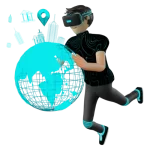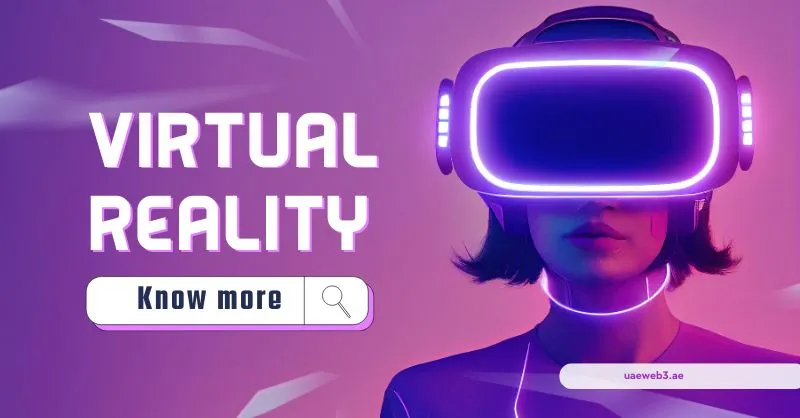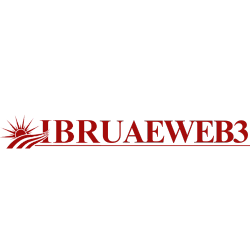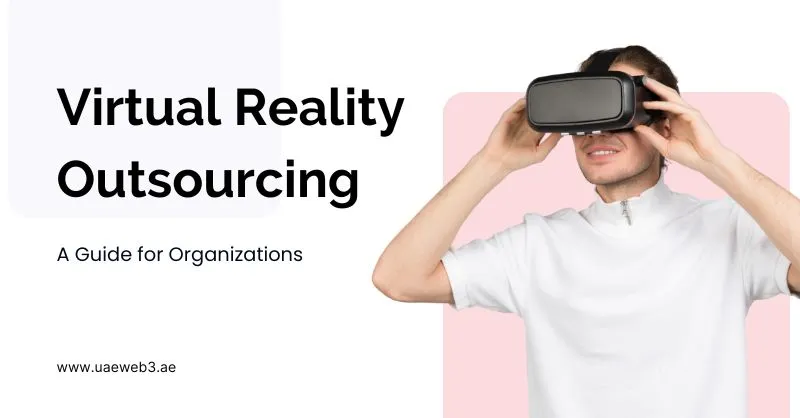Virtual Reality Outsourcing: A Guide for Organizations

It should come as no surprise that a lot of companies are trying to use virtual reality (VR) and augmented reality (AR) to give their clients immersive experiences given how popular these technologies have become in recent years.
Given that the size of the global virtual reality industry is predicted to increase from just $3.7 billion in 2016 to $20.9 billion in 2025, it makes sense for businesses to consider integrating VR into their offerings or marketing campaigns. But creating VR content calls for specific knowledge and abilities that many companies lack internally. Here’s where outsourcing for virtual reality fits in.
Without having to make significant investments in internal staff or resources, organizations may generate immersive VR experiences at a lower cost by outsourcing VR development to a reputable partner. Nevertheless, it might be challenging to identify the best VR/AR businesses for your project. For this reason, we’ve put up a comprehensive guide on outsourcing VR for any size company.
Determine Your VR Objectives and Needs
Prior to outsourcing virtual reality, it’s critical to comprehend your VR objectives and demands. This entails stating the VR project’s goal. One may:
- Use virtual reality (VR) in your product
- Boost user experience (UX) and marketing campaigns
- Improve data visualization and cooperation
- Use it for prototyping, and so forth
Beyond the technical details, you must ascertain the intended results and your target audience.
If you own a furniture business, for example, you might want to develop a virtual reality experience that lets buyers see how a piece of furniture might look in their house. In this instance, you want to boost revenue and consumer engagement.
Determining the VR platform, features, and technology needed for your project is also crucial. For instance, you might need multi-platform compatibility, interactive features, or 360-degree video.
You can make sure your VR outsourcing partner understands your objectives and can achieve the desired results by clearly describing your goals and demands for the technology. Having a strong grasp of your VR objectives and needs also makes it easier for you to assess the project’s success.
Conduct Thorough Research to Find Potential VR Outsourcing Partners
Finding the ideal VR outsourcing partner for your company requires careful study after your VR goals are established.
It’s critical to seek out organizations who specialize in virtual reality development and have a track record of producing VR projects of the highest caliber. An ideal outsourcing partner should possess expertise in your sector or area in order to offer insightful advice tailored to your company’s requirements.
It is imperative that you research internet reviews, portfolios, and qualifications to make sure you are finding the correct partner. This will provide you more insight into their qualifications, experience, and prior results. Directories and business-to-business marketplaces such as UAEWEB3 offer a fully streamlined approach and present you with all available possibilities.
Define Project Scope and Budget
It’s time to set the project scope and budget after discussing possible VR outsourcing service providers with your team. These steps are critical when outsourcing VR. To prevent misconceptions later on, communicate the budget, timetable, and milestones.
You can control expectations, give particular features priority, and pinpoint places where expenses may be cut by doing this. Your project will then be put in a position to succeed.

Ensure Quality Control and Testing Procedures are in Place
In order to make sure that the VR product or service satisfies your standards and expectations, quality control and testing methods are crucial. Prior to working with a possible outsourcing partner, find out if they have established reliable testing and quality control procedures. By doing this, you can make sure that the finished product lives up to your expectations and help prevent any problems with it.
Manage the Project Timeline and Milestones
Controlling the project schedule and milestones is essential to guaranteeing that it is finished on schedule and within budget, much like quality assurance. Even if the project’s scope may change as it develops, make sure the VR outsourcing partner keeps you informed about its status and meets all of the predetermined deadlines.
Before launching, review and assess the finished VR product.
Reviewing and assessing your chosen VR solution in its whole is essential before implementing it. Verifying that the product functions properly and is usable by a large audience involves testing it across many platforms and devices.
You can avoid bad reviews and reputational harm by thoroughly reviewing and evaluating the product before it is released in order to find any problems.
Continue to Communicate for Upcoming Projects
For next projects, keeping in constant contact with the VR outsourcing partner is crucial. After all, continuous collaboration with outsourcers is the foundation of the B2B sector. Having a reliable outsourcing partner is essential for long-term success, irrespective of the business.
In a summary: VR Outsourcing & Upcoming Trends
Experiences in virtual reality are becoming increasingly accessible and immersive. Virtual reality is becoming more affordable and useful with the development of technology and software. It’s anticipated that UX/UI design for VR settings will expand as well, utilizing methods like haptic feedback, spatial audio, and simple gesture controls.
Future trends: social VR systems provide immersive digital venues for interaction, communication, and collaboration. The combination of VR/AR with AI could lead to new experiences and applications. We may anticipate more smooth, captivating, and powerful virtual experiences in a variety of fields as VR develops.
All things considered, understanding how to outsource VR and AR can assist companies in producing creative, high-caliber products and effectively allocating their resources while staying ahead of the curve.
FAQs
Virtual reality technology is being developed by numerous businesses, including industry leaders HTC (Vive), Sony (PlayStation VR), and Facebook (Oculus). Other prominent names in the VR space are Microsoft (Windows Mixed Reality), Google (Daydream), and Samsung (Gear VR). Numerous startups and smaller businesses are also exclusively focused on the development of virtual reality.
Virtual reality is being used by businesses for many different things, such as customer involvement, staff training, product creation and prototyping, marketing, and advertising. VR is also being employed in previously unfeasible fields including data visualization and immersive experiences in the healthcare, education, and entertainment sectors.
The size of the virtual reality business is predicted to increase from just $3.7 billion in 2016 to $20.9 billion in 2025. Advances in VR technology, a growing demand for immersive experiences, and a greater uptake of VR by companies and consumers are all factors contributing to the growth of VR.
Disclaimer: Above all information is for general reference only and sourced from internet, before making any kind of decision please visit the authorized websites of authorities and service providers.

